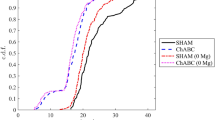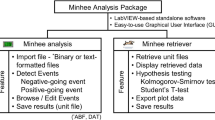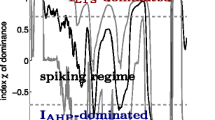Abstract
At present, there are no direct methods to determine the number of synaptic receptor-related channels activated in the course of synaptic transmission (N) or a value of the single-channel conductance (γ). Peak-scaled nonstationary fluctuation analysis (PS NSFA) should be considered the most well-developed indirect approach used for estimating these parameters. Despite the relatively wide using of this approach for the analysis of various synaptic currents, some aspects of possible errors that can occur in the course of data acquisition or their subsequent processing have not been studied. We examined in detail the problem of applicability of PS NSFA in the study of spontaneous and evoked GABA-ergic inhibitory postsynaptic currents (IPSCs). IPSCs were recorded using a dual patch-clamp technique from hippocampal neurons growing in low-density cultures. Parameters of the recorded IPSCs and values for different components of GABA-ergic synaptic transmission reported earlier were used for simulations and PS-NSFA analysis. In Monte Carlo computer simulations of evoked IPSCs, the influence of series resistance, background noise, asynchronicity of transmitter release, GABAA channel properties, dendritic attenuation, and instrumental filtering on γ estimates obtained by PS NSFA was examined. We concluded that the γ and, consequently, N values may be satisfactorily estimated by the suggested approach using spontaneous and evoked IPSCs recorded in inhibitory synaptic connections in hippocampal cultures within a wide range of experimental conditions. We also estimated the mean of the single-channel conductance of synaptic GABAA receptors in neurons from primary hippocampal cultures and found that this value (29 ± 5 pS) agrees well with the high conductance of single synaptic GABAA receptors observed in acute hippocampal slices. This indicates that dissociated cultures are an adequate model for studying the properties of synaptic GABAA receptors.
Similar content being viewed by others
REFERENCES
B. Katz and R. Miledi, “A study of synaptic transmission in the absence of nerve impulses,” J. Physiol., 192, 407–436 (1967).
P. Thakur, D. R. Stevens, Z. H. Sheng, and J. Rettig, “Effects of PKA-mediated phosphorylation of Snapin on synaptic transmission in cultured hippocampal neurons,” J. Neurosci., 24, 6476–6481 (2004).
S. F. Traynelis and F. Jaramillo, “Getting the most out of noise in the central nervous system,” Trends Neurosci., 21, 137–145 (1998).
R. Dingledine, K. Borges, D. Bowie, and S. F. Traynelis, “The glutamate receptor ion channels,” Pharmacol. Rev., 51, 7–61 (1999).
A. Thalhammer, T. Morth, N. Strutz, and M. Hollmann, “A desensitization-inhibiting mutation in the glutamate binding site of rat alpha-amino-3-hydroxy-5-methyl-4-isoxazole propionic acid receptor subunits is dominant in heteromultimeric complexes,” Neurosci. Lett., 277, 161–164 (1999).
A. Semyanov, M. C. Walker, D. M. Kullmann, and R. A. Silver, “Tonically active GABAA receptors: modulating gain and maintaining the tone,” Trends Neurosci., 27, 262–269 (2004).
I. Mody and R. A. Pearce, “Diversity of inhibitory neurotransmission through GABA(A) receptors,” Trends Neurosci., 27, 569–575 (2004).
J. Y. Yeung, K. J. Canning, G. Zhu, et al., “Tonically activated GABAA receptors in hippocampal neurons are high-affinity, low-conductance sensors for extracellular GABA,” Mol. Pharmacol., 63, 2–8 (2003).
P. S. Mangan, C. Sun, M. Carpenter, et al., “Cultured hippocampal pyramidal neurons express two kinds of GABAA receptors,” Mol. Pharmacol., 67, 775–788, (2005).
E. Neher and C. F. Stevens, “Conductance fluctuations and ionic pores in membranes,” Annu. Rev. Biophys. Bioeng., 6, 345–381 (1977).
S. F. Traynelis, R. A. Silver, and S. G. Cull-Candy, “Estimated conductance of glutamate receptor channels activated during EPSCs at the cerebellar mossy fibre-granule cell synapse,” Neuron, 11, 279–289 (1993).
R. A. Silver, S. G. Cull-Candy, and T. Takahashi, “Non-NMDA glutamate receptor occupancy and open probability at a rat cerebellar synapse with single and multiple release sites,” J. Physiol., 494, Part 1, 231–250 (1996).
A. Momiyama, R. A. Silver, M. Hausser, et al., “The density of AMPA receptors activated by a transmitter quantum at the climbing fibre-Purkinje cell synapse in immature rats,” J. Physiol., 549, 75–92 (2003).
Z. Nusser, D. Naylor, and I. Mody, “Synapse-specific contribution of the variation of transmitter concentration to the decay of inhibitory postsynaptic currents,” Biophys. J., 80, 1251–1261 (2001).
I. Mody, Y. De Koninck, T. S. Otis, and I. Soltesz, “Bridging the cleft at GABA synapses in the brain,” Trends Neurosci., 17, 517–525 (1994).
M. V. Jones and G. L. Westbrook, “Desensitized states prolong GABAA channel responses to brief agonist pulses,” Neuron, 15, 181–191 (1995).
M. W. Hill, P. A. Reddy, D. F. Covey, and S. M. Rothman, “Contribution of subsaturating GABA concentrations to IPSCs in cultured hippocampal neurons,” J. Neurosci., 18, 5103–5111 (1998).
M. V. Storozhuk, S. Y. Ivanova, T. A. Pivneva, et al., “Post-tetanic depression of GABAergic synaptic transmission in rat hippocampal cell cultures,” Neurosci. Lett., 323, 5–8 (2002).
Y. De Koninck and I. Mody, “Noise analysis of miniature IPSCs in adult rat brain slices: properties and modulation of synaptic GABAA receptor channels,” J. Neurophysiol., 71, 1318–1335 (1994).
D. Johnston and S. M. Wu, Foundations of Cellular Neurophysiology, A Bratsord Book, London (1995).
N. Spruston and D. Johnston, “Perforated patch-clamp analysis of the passive membrane properties of three classes of hippocampal neurons,” J. Neurophysiol., 67, 508–529 (1992).
J. D. Clements, “Transmitter time-course in the synaptic cleft: its role in central synaptic function,” Trends Neurosci., 19, 163–171 (1996).
M. Hausser and A. Roth, “Estimating the time course of the excitatory synaptic conductance in neocortical pyramidal cells using a novel voltage jump method,” J. Neurosci., 17, 7606–7625 (1997).
D. Debanne, “Information processing in the axon,” Nat. Rev. Neurosci., 5, 304–316 (2004).
C. F. Stevens, “Neurotransmitter release at central synapses,” Neuron, 40, 381–388 (2003).
Z. Nusser, S. Cull-Candy, and M. Farrant, “Differences in synaptic GABA(A) receptor number underlie variation in GABA mini amplitude,” Neuron, 19, 697–709 (1997).
S. G. Brickley, S. G. Cull-Candy, and M. Farrant, “Single-channel properties of synaptic and extrasynaptic GABAA receptors suggest differential targeting of receptor subtypes,” J. Neurosci., 19, 2960–2973 (1999).
D. Perrais and N. Ropert, “Effect of zolpidem on miniature IPSCs and occupancy of postsynaptic GABAA receptors in central synapses,” J. Neurosci., 19, 578–588 (1999).
P. S. Mangan, C. Sun, M. Carpenter, et al., “Cultured hippocampal pyramidal neurons express two kinds of GABAA receptors,” Mol. Pharmacol., 67, 775–788 (2005).
L. Forti, M. Bossi, A. Bergamaschi, et al., “Loose-patch recordings of single quanta at individual hippocampal synapses,” Nature, 388, 874–878 (1997).
T. A. Benke, A. Luthi, M. J. Palmer, et al., “Mathematical modelling of non-stationary fluctuation analysis for studying channel properties of synaptic AMPA receptors,” J. Physiol., 537, 407–420 (2001).
Author information
Authors and Affiliations
Corresponding author
Additional information
Neirofiziologiya/Neurophysiology, Vol. 37, No. 4, pp. 379–388, July–August, 2004.
Rights and permissions
About this article
Cite this article
Markova, O., Stepanyuk, A., Tsugorka, T. et al. Applicability of Peak-Scaled Nonstationary Fluctuation Analysis to the Study of Inhibitory Synaptic Transmission in Hippocampal Cultures. Neurophysiology 37, 333–343 (2005). https://doi.org/10.1007/s11062-006-0008-z
Received:
Issue Date:
DOI: https://doi.org/10.1007/s11062-006-0008-z




